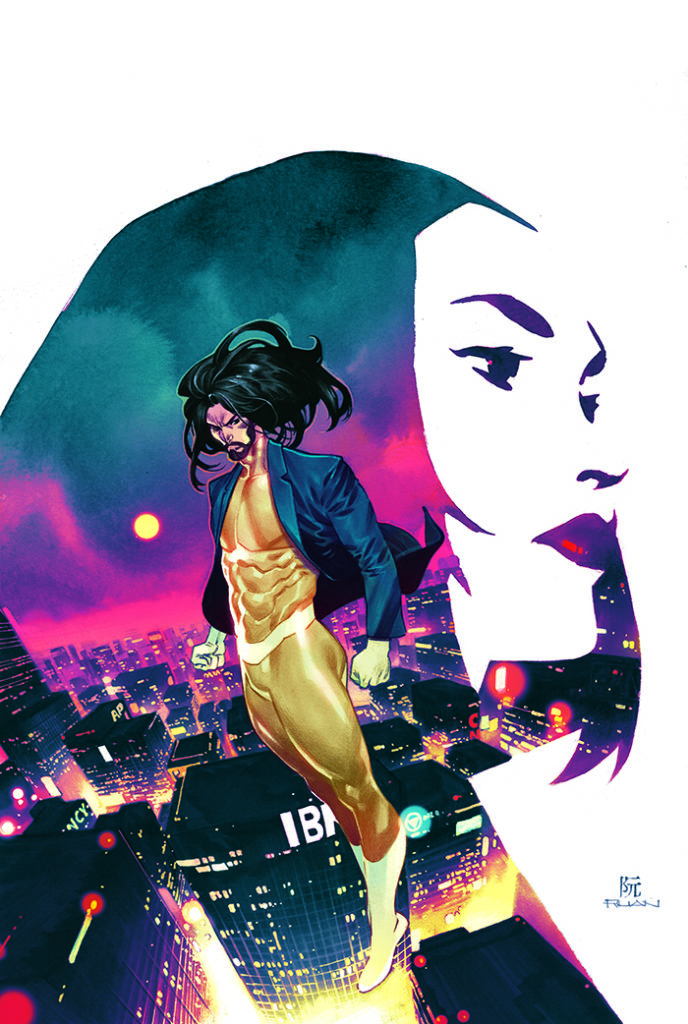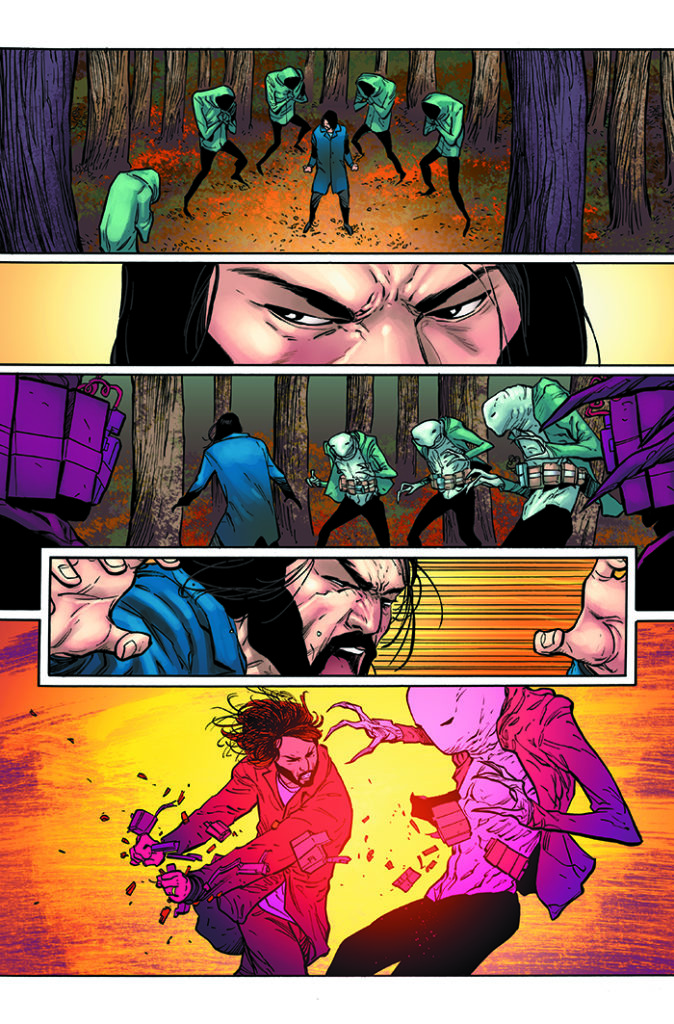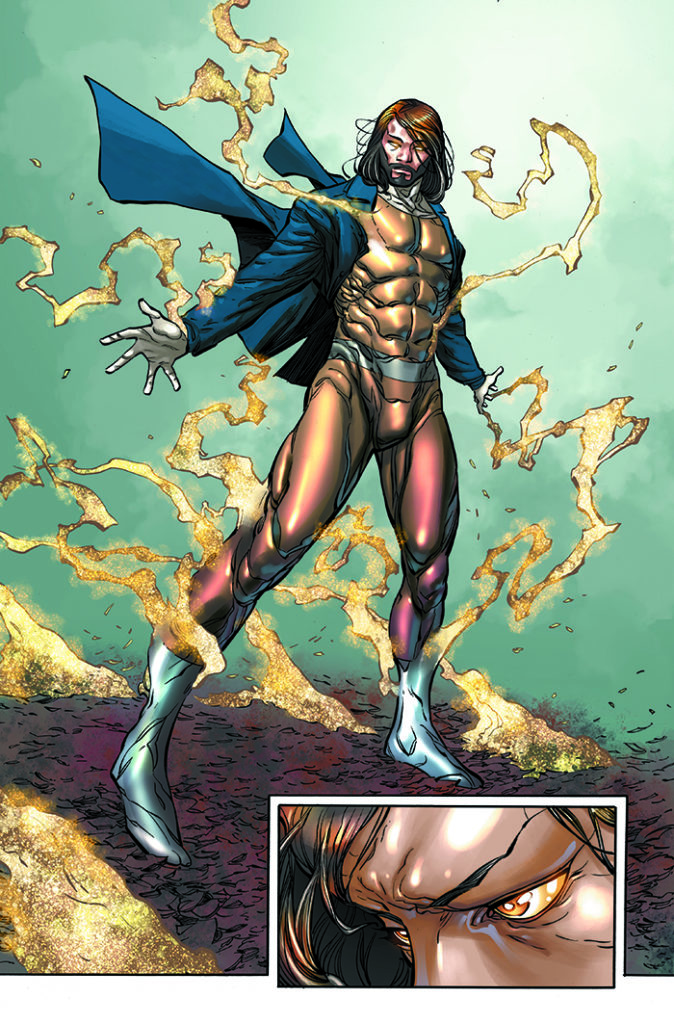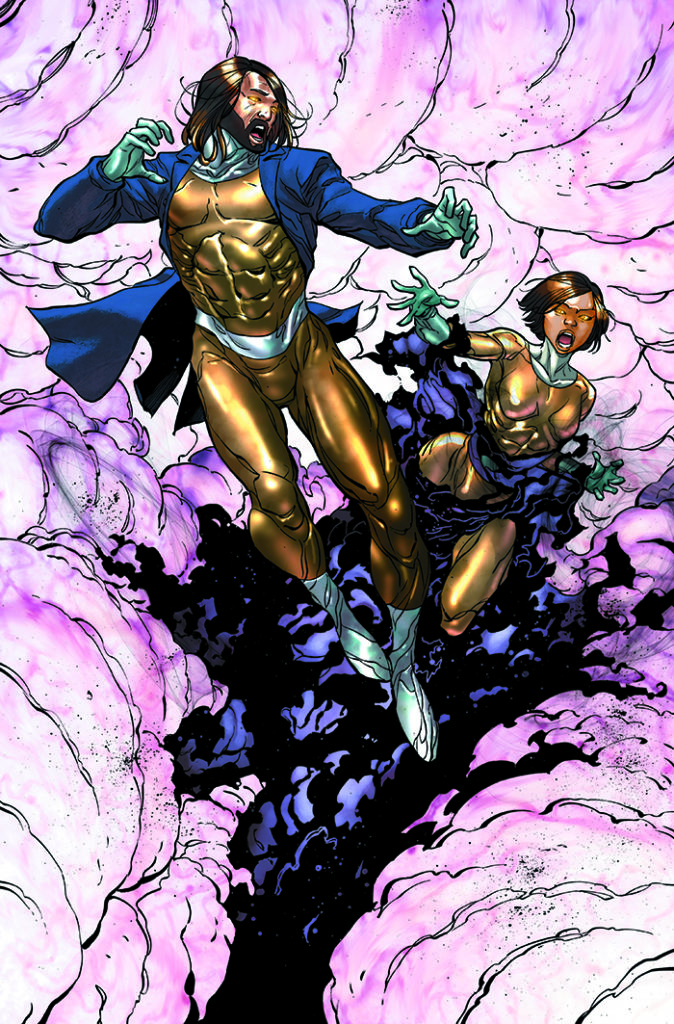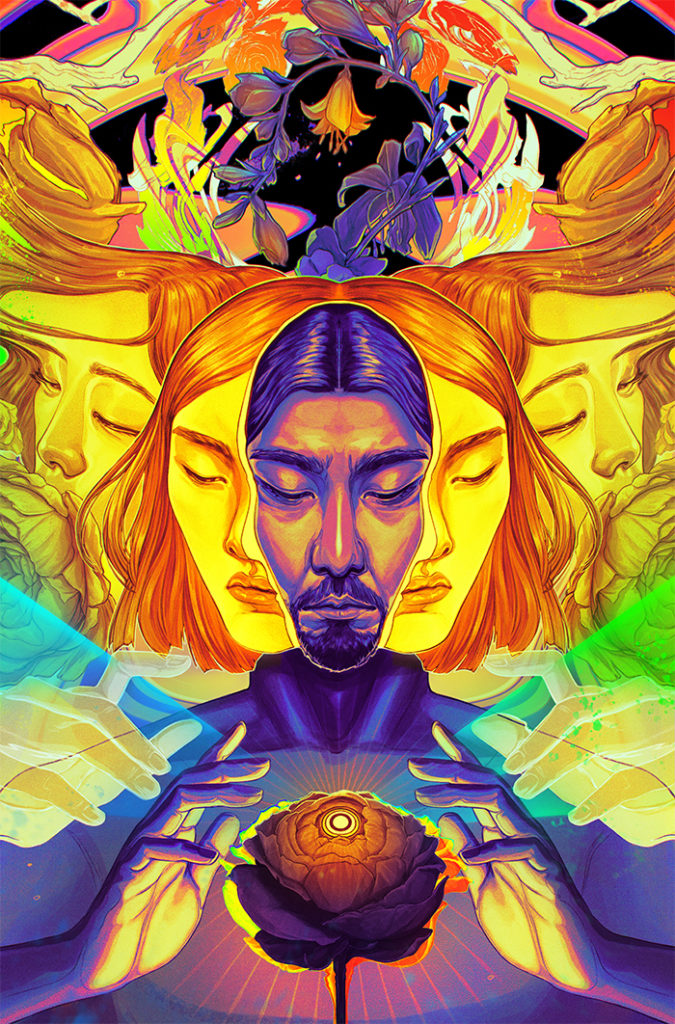Meet Duo: Earth-M’s Debut Superhero is of Two Minds
By Alex Jaffe | DC Comics
Last year, the world of Milestone Media made its long-awaited return to comic shelves. Static, Icon, Rocket and Hardware live again in a shared universe of their own, living the kinds of stories they were created to tell. In 2022, Milestone is only getting bigger. Make way for Earth-M.
The “Earth-M” line is a collection of new concepts and characters created by original Milestone cofounder Denys Cowan and current Milestone relaunch shepherd Reginald Hudlin, both inspired by and nestled within the Milestone universe. In time, these new heroes may meet their Milestone forebears, but now is the time for Milestone to do what it was always meant to through Earth-M: broaden perspectives on the superhero genre as a whole with ideas you’ve never seen before.
One of the first titles in the Earth-M line will be the six-issue limited series Duo, the story of two lovers, both alike in scientific accomplishment, merged into one body through a nanotechnology experiment. While this has granted them extraordinary powers, it has also erased the boundaries between them. Can a love survive when all things must be shared and independence lost? We spoke with author Greg Pak (Action Comics, Batman/Superman), penciler Khoi Pham (Teen Titans) and inker Scott Hanna (too many credits to list) to learn everything we can about this exciting new title.
Duo is the story of doctors Kelly Vu and David Kim, who are fused into one being by nanotechnology overnight. What was Kelly and David’s relationship like before their fusion? Who were they as individuals before they became one person?
Greg Pak: I think the fun part of this story is that it’s asking the question of “What if you were privy to every single thought, feeling and impulse of the person you most love in the world?”
We talk about people finishing each other’s sentences when they really know each other, and that’s exactly what Dr. Kelly Vu and Dr. David Kim do in some of the opening pages of this. They work together, they live together, they love together. They are in that fairly early stage of a relationship where everything makes sense with the other person perfectly. But what happens when you literally can’t escape the other person? When the other person is literally in your mind? That’s what hooked me into the project when Reggie first talked to me about it and pitched it to me.
So, who are they? They are brilliant scientists, they are engaged, and they have slightly different impulses. As you go along in the book, you realize Kelly is a bigger risk-taker and David’s a little more cautious, in life and in everything else. But they complement each other, and they have these huge ambitions together. The challenge is to see what happens when people who seem so similar are suddenly, entirely connected, and whether they actually are so similar after all. And whether being similar is even the objective!
Scott Hanna: I’ve been happily married for a long time, but my wife and I are basically polar opposites in a lot of ways. But that helps. We work well together because we’re not the same. And like any relationship, you’re going to have arguments, you’re going to have fights. So, this way of dealing with relationships is really cool. How that really functions, and dysfunctions as well.
Khoi Pham: Yeah, and on the visual side of things, Greg and I were talking about this way, way at the beginning, which was like a hundred years ago at this point.
GP: Yeah, literally five years ago!
KP: So, casting these characters, right? It was a Vietnamese-American and a Korean-American, but it was a really great opportunity for reinventing in the image what we would like. One of the things I really wanted to do, and Greg was completely on board with it, was depicting a dark-skinned Asian. That’s not very frequent (in comics). Unfortunately, it’s kind of an issue in Asian culture. So, we made Kelly darker.
These were the intentions we brought to it, and I’m glad we were able to not just have Asian-Americans, but darker-skinned Asian-Americans. It’s really fun just taking Greg’s ideas and how he fleshes these characters out and visually represent them. Subtle stuff. Dave’s wearing a baseball tee in Giants colors, so he’s like the Stats Guy, right? And Kelly’s got a Wonder Woman t-shirt. So, little hints and visual cues that way. She really takes the superhero approach, like, “Let’s go knock some heads around!” And Dave’s more, “Let’s plan it out!
Speaking of that representation, a big part of the reason Milestone Media was founded, and a mission the Earth-M comics will continue, was to present heroes representing more marginalized communities, as created and told by writers and artists from those backgrounds themselves. How does Duo attempt to represent the Asian-American experience?
GP: No single project can represent the experiences of a whole community, so I’m not going to make any sweeping statements like that. But I’m thrilled about the project because so many Asian-Americans live in Pan-Asian families, where you have people of multiple backgrounds in the same family. And here, we’ve got a Korean-American man and a Vietnamese-American woman. Those kinds of relationships are everywhere, but they’re seldom represented, you know? And so, there’s something nice about normalizing that kind of experience.
There’s also a thing where sometimes by having one Asian character in a story, that one Asian bears all this weight of representing Asian-America. It’s impossible! So, having this be just one more story among many, many Asian and Asian-American stories that are out there, with more coming out every day, it’s a thrill to have another angle. To be another project with another window to another experience. I like that it shows some older characters and a couple. It’s a mature love story. And I think that kind of thing is still sort of rare.
Especially in superhero comics.
GP: Yeah! So that feels special. A chance to dig into that kind of stuff. It is ridiculous, but having an Asian-American romantic lead is still rare in American media. I’ve been doing this in one form or another for thirty years now. Making films, writing comics. Specifically doing Asian-American storytelling. And there’s never been a better time than now, in terms of the diversity and breadth of Asian-American storytelling that’s getting funded and distributed.
One of the nice things about having so many things coming out is that you can have some projects that are explicitly about Asian-American history, or family dynamics. And you can also have projects which aren’t, on the surface, directly about that at all. The characters aren’t necessarily struggling with immigrant experiences, or family trauma, or whatever typical Asian-American story you often see, like second-generation kids not doing what their first-generation parents want them to do. I love all those stories. I think those stories are great. But I think there’s also room for totally loopy sci-fi stuff with Asian-American characters in it.
KP: That’s what I love about this story and stories that are told this way in terms of representation through just being in it, but not talking about it in the story. It just happens to be Asian-Americans. I think it’s important to put representation out there and just see it, see it, see it. They’re just in a sci-fi superhero book. The costume was deliberately a classic superhero costume. Yeah, they’re Asian-Americans, but this is a science fiction superhero story, and this is just how they happen to look. But we’re not going to talk about it, it’s just what it is.
GP: There are subtleties to the whole story that may resonate with Asian-American readers in a specific way. I think there’s something to these second or third generation characters who are much more open about their feelings than their immigrant parents or grandparents might be. That’s where our characters start off. They’re very honest and open and intimate with each other. But then we kind of challenge that. Like, how open are you really? To me, that resonates, coming from Korean and German-English stock. My grandparents were very reticent. They hardly ever spoke about their emotional states, and I’ll ramble on about all my feelings at the drop of a hat, because it’s a different world. But at the same time, there’s a part of me that’s very private. So, is that an Asian-American story? It might be. It’s up to readers to get what they want out of it.
Nanotechnology is also a big part of this story. There’s a visual challenge with nanotech sci-fi stories where it ends up falling into this category of “gray goo.” How do you keep nanotech interesting visually in a comic book?
GP: Instead of gray goo, we went with gold mist. (laughter)
And that makes all the difference.
SH: It’s more sparkly, yeah.
GP: There’s a big swirling tank of gold mist and it’s kind of romantic and beautiful. Chris Sotomayor is the colorist.
KP: I was going to say, huge credit to him on that.
You’re talking about the romantic symbology of the gold mist, which makes me wonder how much is the nanotechnology meant to be a narrative device, and how much is this meant to be a hard sci-fi story?
GP: Well, everything is a narrative device, in every story. Literally every single choice you make in a story is a narrative device. The premise is that you’ve got this character—and I don’t know how much we should spill—but they become ridiculously powerful. So, you’re not only finding yourself with your lover’s mind as sort of a permanent part of your own mind, you’re not only experiencing everything your partner’s experiencing, but you’re in this body that is virtually impervious to damage. You’ve got this ridiculous amount of power, and the nanotechnology sets that up.
This technology doesn’t exist. It is science fiction, but there are internal rules to it all and they connect all the threads here. David and Kelly are scientists who want to use this nanotechnology to cure diseases and ease human suffering. So, this is a fictional narrative device that also makes sense given the fictional science we’re dealing with here, but it serves this emotional story of these people who want to do good. They’re do-gooders. But what happens when you have so much power is that you can throw things out of balance. That’s one of these classic superhero themes, and this whole nanotech concept lets us dig at that from interesting places. It’s also significant because it’s created by humans. It’s something they have gone out and gotten. So, it’s not like—
SH: Flash getting hit by a lightning bolt.
GP: Exactly. They went out and got this. So, there’s an increased sense of personal responsibility to this whole thing that I think is interesting.
KP: With the nanos, they created it. I always sort of imagined it as being like a baby. It has a personality, and looking back, there’s this one scene where David and Kelly are being affectionate and the nanos create, like, heart shapes. Its shape and texture changes based on how it feels about its creators. It’s very subtle.
GP: And they nurture it, too. You have these kind of flashback scenes where they treat it like their baby. They’re staying up all night with it.
SH: One of the cool things too, is that at the very beginning, it doesn’t do what they want it to do. The intent is not what the result is. That’s also like a child—you can’t control it. Once it’s there, it’s got a life of its own.
KP: Absolutely.
So, this is a story about parenthood, as well as partnership.
GP: (Laughs) That’s sort of more of a buried theme, but… yeah.
Duo #1 is written by Greg Pak and drawn by Khoi Pham and Scott Hanna. Cover art is by Dike Ruan, with a variant cover by Denys Cowan and a 1:25 variant cover by Nimit Malavia. Look for it at comic shops and digital retailers on May 17, 2022

